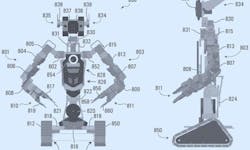Author:
You’ve ordered a robot online and are booting it up at home. At first the bot doesn’t do much of anything; it simply follows you around and observes your daily routine: walking the dog, making lasagna, washing the dishes. But before long the bot has learned to be your surrogate, shouldering quotidian tasks so you can focus on more interesting ones.
That’s the world envisioned by Suzanne Gildert and Geordie Rose. They run Kindred, an ultra-secretive artificial intelligence company based in Vancouver and funded in part by Google’s venture capital arm. Gildert and Rose started Kindred on the principle that the best way to make robots as smart as humans, is to put them in our shoes, and teach them to learn the same way we do. With the help of an all-star advisory board of AI experts, Kindred is already making progress toward that audacious goal.
“Humans and AIs working together to control robots are always better than either by themselves,” said Rose, dressed in a black t-shirt and blazer at Kindred’s office, located in a brick heritage building across from the athletes village built for the 2010 Winter Olympics.
Teaching computers to learn on their own is the core aim of AI research. The world’s largest tech companies, including Facebook, Google and China’s Baidu, are all racing to develop the best techniques. There have been breakthroughs in speech and image recognition, but machines still struggle to handle basic physical tasks such as grasping objects. Improving robots’ physical dexterity is the first problem Kindred is trying to tackle.
Gildert, a physicist by training, came up with the idea of using human control to train robot algorithms while working at D-Wave, a Rose-founded company that’s become a force in quantum computing, an esoteric technology that bypasses physical laws to crunch data faster than traditional machines. Gildert was trying to figure out the best way to train machines how to move like humans but, unlike image recognition algorithms that can tap into reams of pictures on the web, there wasn’t an obvious set of training data.
“That doesn’t exist,” Gildert said. “The light bulb moment was, ‘well, a human could supply that training data by moving the robot and if you want good training data you need an immersive situation.”’
Gildert and Rose left D-Wave in 2014 to found Kindred. Since then they’ve assembled some 50 robots for testing purposes. In a typical experiment, a human operator wears a virtual reality headset to “see” what the robot is seeing and uses handheld controllers to help the machine pick up an object. Every time the human helps the bot, the algorithms use the data to learn and make the machine smarter over time.
Kindred plans to use AI and a person, or possibly a monkey, to teach robots to move more naturally.
Illustration: IEEE Spectrum; images: U.S. Patent Application US20160243701A1 via Google Patents
The technique lets robots do things they can’t do right now on their own while simultaneously making them more capable, Rose said. Eventually, he says, the techniques could be applied to more abstract tasks, like learning how to make someone laugh or intuit how they’re feeling. He calls the current technology “proto-intelligences” akin to great-great-grandparents of what one day will be true, human-level AI.
Rose assembled his team, which has grown to include 34 people spread over offices in Vancouver, Toronto and San Francisco, by drawing on contacts he made while selling D-Wave’s multimillion-dollar machines to Google, the U.S. government and other organizations. Kindred’s advisory board includes such heavyweights as Russ Salakhutdinov, who recently became Apple’s director of AI research. “Very rarely do you see this level of top-50 people in the deep learning space in one company,” said Andy Wheeler, a partner at Google Ventures who led the firm’s investment in Kindred.
At some point, Kindred plans to publish its findings in academic journals or present them at conferences, a practice AI researchers employ to validate their breakthroughs and invite others to build on them. “Obviously it’s too early to say is this definitely the way we get to real machine intelligence,” Wheeler said. But Kindred’s unique approach and all-star team convinced him to invest. The company has attracted $15 million from investors. Along with Google, they include Eclipse, Data Collective, First Round Capital and Bloomberg Beta, the venture capital arm of Bloomberg LP. Kindred declined to comment on its valuation.
Kindred is now focusing on bringing its work into the real world through partnerships with existing industrial robotics companies, said Rose, who declined to discuss specific discussions or agreements. “We saw an opportunity to use that existing base of robots that will be out there in the world in their hundreds of thousands,” Gildert said.
Take the role of sorting boxes in a warehouse run by Amazon or Wal-Mart. A single human operator could be plugged into multiple robots, stepping in when they run into a problem but otherwise letting them pick up and re-arrange the boxes on their own. The more robots Kindred can plug into, the more data it will have to train its algorithms on, creating a snowball effect, Gildert said.
Eventually, the company’s technology could be used to help make multi-purpose robots that can learn any task -- from packing groceries to conducting a symphony to cheering up someone who’s sad -- simply by watching how humans do those things.
“The opportunity here to build general-purpose machines that have the plethora of capabilities that humans have is unprecedented,” Rose said.












